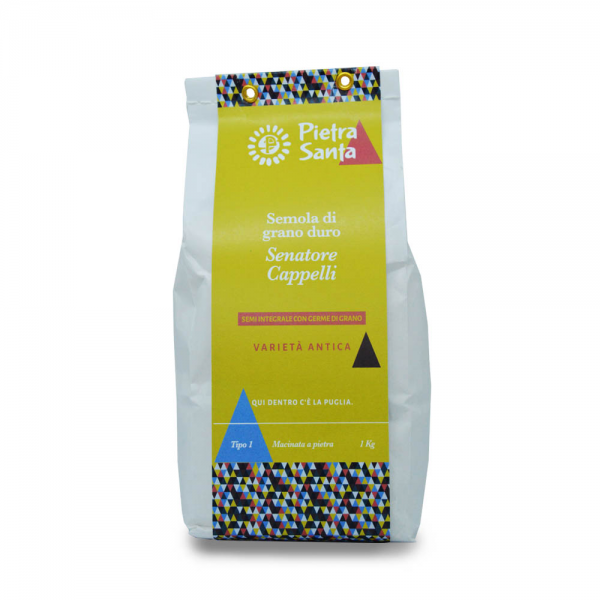
Senatore Cappelli hard wheat semolina flour
Spedizione gratuita per ordini superiori a 120 euro - SOLO IN ITALIA
- Write a review
0232
New product
Senatore Cappelli hard wheat semolina half whole grain with wheat germ -flour Type 1- Pack of 1Kg
SPEDIZIONE IN EUROPA - SHIPPING IN EUROPE
The Senatore Cappelli hard wheat, is a variety of hard wheat selected in 1915 in Foggia by the geneticist Nazareno Strampelli. However, the name is a tribute to Raffaele Cappelli, Senator of the Kingdom of Italy, who in the early 1900s was the author of the first agrarian reform as well as diffuser of this precious variety.
Senatore Cappelli hard wheat flour has exceptional organoleptic characteristics, it gives an unmistakable flavor and aroma to pasta, bread, friselle, pizzas and even some types of desserts such as biscuits and pies.
The health properties are innumerable. As the grain retains the wheat germ during processing, the flour obtained is rich in vitamin E, proteins, amino acids, minerals and unsaturated fats, many of which have antioxidant activities. It is extremely digestible and naturally low in gluten.
"Ancient grains" are defined as all the varieties that were cultivated before they began to select grains for industrial purposes, approximately from the seventies of the twentieth century.
These grains first of all tell of a territory, of the link between it and man, of culture and tradition. They are a tribute to biodiversity and a healthy and environmentally friendly agriculture.
In comparison with modern ones, these cereals differ in appearance, genetics and productivity, both in quantitative and qualitative terms.
Ancient grains are:
-healthier than modern ones because they are not grown with chemical fertilizers. Furthermore, given the smaller production, the transformation chain is artisanal: this means that the product is processed more slowly and at lower temperatures which do not denature the nutrients. Finally, there are also scientific studies that demonstrate their higher content in mineral salts and vitamins.
-They are more digestible: because they have a lower strength and a lower gluten index (which is why they are also more difficult to work with).
-They prevent intolerances: that ancient grains irritate the intestine less than modern ones. Whether it is due to gluten is not yet clear, which is why today we no longer speak of gluten intolerance but of wheat intolerance.
-They are tastier: if you ask a miller he will tell you that many ancient grains can be distinguished by the scent that is released during milling, while modern grains are not very fragrant. In addition, the artisanal or half-artisanal production chain of ancient grains gives life to tastier products also due to the highest quality processing, while the modern varieties designed for industrial production are generally used in medium-low quality products.
The wheat germ is the fundamental part of the seed from which the plant is born and grows and is very rich in nutrients: Omega 3, Omega 6, vitamins A, E, D and vitamins of group B (B1, B3, B5 and B6), trace elements: calcium, potassium, silicon, phosphorus, sulfur, zinc, copper, iron, magnesium, manganese, selenium and molybdenum.
In the refining processes, the germ is eliminated because the nutrients and fatty acids it contains would compromise the organoleptic characteristics and lead the finished product to go rancid quickly.
In addition, in the preparations it gives the dough greater elasticity, more aroma, flavor, digestibility and lightness. Promotes greater water absorption, for superior leavening and result.


